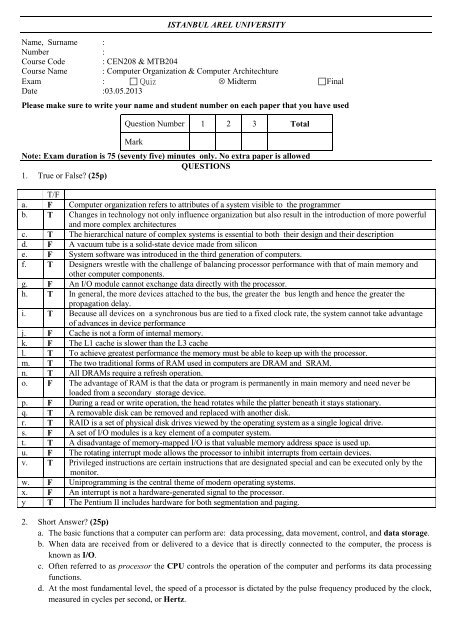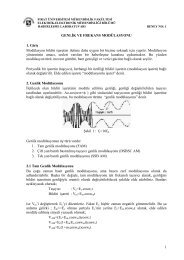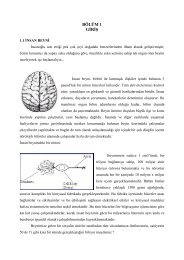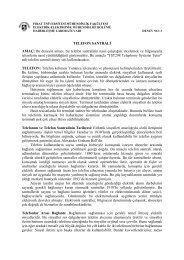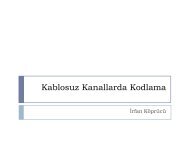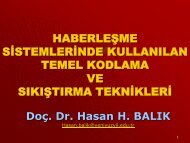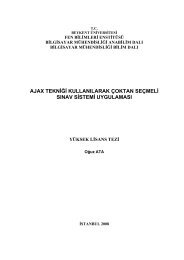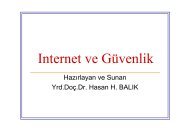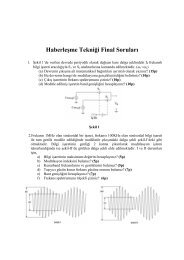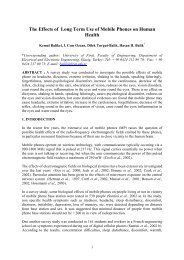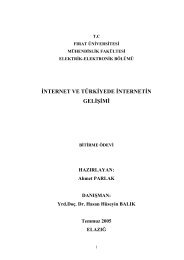beykent üniÌversiÌtesiÌ - Hasan Hüseyin BALIK
beykent üniÌversiÌtesiÌ - Hasan Hüseyin BALIK
beykent üniÌversiÌtesiÌ - Hasan Hüseyin BALIK
You also want an ePaper? Increase the reach of your titles
YUMPU automatically turns print PDFs into web optimized ePapers that Google loves.
ISTANBUL AREL UNIVERSITY<br />
Name, Surname :<br />
Number :<br />
Course Code : CEN208 & MTB204<br />
Course Name : Computer Organization & Computer Architechture<br />
Exam : Quiz ⊗ Midterm Final<br />
Date :03.05.2013<br />
Please make sure to write your name and student number on each paper that you have used<br />
Question Number 1 2 3 Total<br />
Mark<br />
Note: Exam duration is 75 (seventy five) minutes only. No extra paper is allowed<br />
QUESTIONS<br />
1. True or False (25p)<br />
T/F<br />
a. F Computer organization refers to attributes of a system visible to the programmer<br />
b. T Changes in technology not only influence organization but also result in the introduction of more powerful<br />
and more complex architectures<br />
c. T The hierarchical nature of complex systems is essential to both their design and their description<br />
d. F A vacuum tube is a solid-state device made from silicon<br />
e. F System software was introduced in the third generation of computers.<br />
f. T Designers wrestle with the challenge of balancing processor performance with that of main memory and<br />
other computer components.<br />
g. F An I/O module cannot exchange data directly with the processor.<br />
h. T In general, the more devices attached to the bus, the greater the bus length and hence the greater the<br />
propagation delay.<br />
i. T Because all devices on a synchronous bus are tied to a fixed clock rate, the system cannot take advantage<br />
of advances in device performance<br />
j. F Cache is not a form of internal memory.<br />
k. F The L1 cache is slower than the L3 cache<br />
l. T To achieve greatest performance the memory must be able to keep up with the processor.<br />
m. T The two traditional forms of RAM used in computers are DRAM and SRAM.<br />
n. T All DRAMs require a refresh operation.<br />
o. F The advantage of RAM is that the data or program is permanently in main memory and need never be<br />
loaded from a secondary storage device.<br />
p. F During a read or write operation, the head rotates while the platter beneath it stays stationary.<br />
q. T A removable disk can be removed and replaced with another disk.<br />
r. T RAID is a set of physical disk drives viewed by the operating system as a single logical drive.<br />
s. F A set of I/O modules is a key element of a computer system.<br />
t. T A disadvantage of memory-mapped I/O is that valuable memory address space is used up.<br />
u. F The rotating interrupt mode allows the processor to inhibit interrupts from certain devices.<br />
v. T Privileged instructions are certain instructions that are designated special and can be executed only by the<br />
monitor.<br />
w. F Uniprogramming is the central theme of modern operating systems.<br />
x. F An interrupt is not a hardware-generated signal to the processor.<br />
y T The Pentium II includes hardware for both segmentation and paging.<br />
2. Short Answer (25p)<br />
a. The basic functions that a computer can perform are: data processing, data movement, control, and data storage.<br />
b. When data are received from or delivered to a device that is directly connected to the computer, the process is<br />
known as I/O.<br />
c. Often referred to as processor the CPU controls the operation of the computer and performs its data processing<br />
functions.<br />
d. At the most fundamental level, the speed of a processor is dictated by the pulse frequency produced by the clock,<br />
measured in cycles per second, or Hertz.
e. Amdahls law deals with the potential speedup of a program using multiple processors compared to a single<br />
processor.<br />
f. The Intel 8080 was the world’s first general-purpose microprocessor.<br />
g. A MBR register contains the data to be written into memory or receives the data read from memory.<br />
h. A(n) I/O interrupt is generated by an I/O controller to signal normal completion of an operation, request service<br />
from the processor, or to signal a variety of error conditions.<br />
i. Bus lines can be separated into two generic types: dedicated and multiplexed.<br />
j. The most commonly used physical types of memory are: semiconductor memory, magnetic surface memory<br />
(used for disk and tape), and optical and magneto-optical.<br />
k. External, nonvolatile memory is referred to as secondary or auxiliary memory.<br />
l. One byte equals 8 bits.<br />
m. The simplest of the error-correcting codes is the Hamming code.<br />
n. Three common forms of read-mostly memory are: EPROM, EEPROM, and flash memory.<br />
o. A dynamic RAM is made with cells that store data as charge on capacitors.<br />
p. The floppy disk is a small, flexible platter and the least expensive type of disk.<br />
q. The RAID strategy employs multiple disk drives and distributes data in such a way as to enable simultaneous<br />
access to data from multiple drives, thereby improving I/O performance and allowing easier incremental increases<br />
in capacity.<br />
r. Data is organized on the platter in a concentric set of rings called tracs.<br />
s. In DMA mode the I/O module and main memory exchange data directly, without processor involvement.<br />
t. Interface to the processor and memory via the system bus or central switch and interface to one or more<br />
peripheral devices by tailored data links are two major functions of an I/O Module.<br />
u. When the processor, main memory, and I/O share a common bus, two modes of addressing are possible: memory<br />
mapped and isolated.<br />
v. The Operating System is a program that manages the computer’s resources, provides services for programmers,<br />
and schedules the execution of other programs.<br />
w. The Kernel , or nucleus, contains the most frequently used functions in the OS.<br />
x. Early computer systems presented two main problems: setup time and schedulling.<br />
y. Because a process executes only in main memory, that memory is referred to as real memory.<br />
3. Consider two different machines, with two different instruction sets, both of which have a clock rate of 200 MHz.<br />
The following measurements are recorded on the two machines running a given set of benchmark programs:<br />
Instruction Type Instruction<br />
Count<br />
(millions)<br />
Cycles per<br />
Instruction<br />
Machine A<br />
Arithmetic and logic<br />
Load and store<br />
Branch<br />
Others<br />
Machine B<br />
Arithmetic and logic<br />
Load and store<br />
Branch<br />
Others<br />
8<br />
4<br />
2<br />
4<br />
10<br />
8<br />
2<br />
4<br />
a. Determine the effective CPI, MIPS rate, and execution time for each machine (30p)<br />
b. Comment on the results. (20p)<br />
1<br />
3<br />
4<br />
3<br />
1<br />
2<br />
4<br />
3
a.<br />
CPI<br />
CPI<br />
A<br />
MIPS<br />
CPU<br />
B<br />
CPU<br />
A<br />
MIPS<br />
B<br />
=<br />
A<br />
=<br />
B<br />
∑<br />
f<br />
=<br />
CPI × 10<br />
I<br />
=<br />
∑<br />
f<br />
=<br />
CPI × 10<br />
I<br />
=<br />
c<br />
c<br />
CPI × I<br />
I<br />
× CPI<br />
f<br />
I<br />
c<br />
A<br />
CPI × I<br />
c<br />
B<br />
i<br />
i<br />
× CPI<br />
f<br />
A<br />
B<br />
i<br />
6<br />
( 8×<br />
1+<br />
4×<br />
3 + 2×<br />
4 + 4×<br />
3)<br />
6<br />
( 8 + 4 + 2 + 4)<br />
× 10<br />
200×<br />
10<br />
=<br />
2.22×<br />
10<br />
6<br />
18×<br />
10 × 2.2<br />
=<br />
= 0.2 s<br />
6<br />
200×<br />
10<br />
i<br />
6<br />
=<br />
=<br />
( 10×<br />
1+<br />
8×<br />
2 + 2×<br />
4 + 4×<br />
3)<br />
6<br />
( 10 + 8 + 2 + 4)<br />
× 10<br />
200×<br />
10<br />
=<br />
1.92×<br />
10<br />
= 90<br />
= 104<br />
6<br />
24×<br />
10 × 1.92<br />
=<br />
= 0.23s<br />
6<br />
200×<br />
10<br />
6<br />
6<br />
6<br />
6<br />
× 10<br />
6<br />
× 10<br />
≈ 2.22<br />
6<br />
≈1.92<br />
b. Although machine B has a higher MIPS than machine A, it requires a longer CPU time to execute the<br />
same set of benchmark programs.


